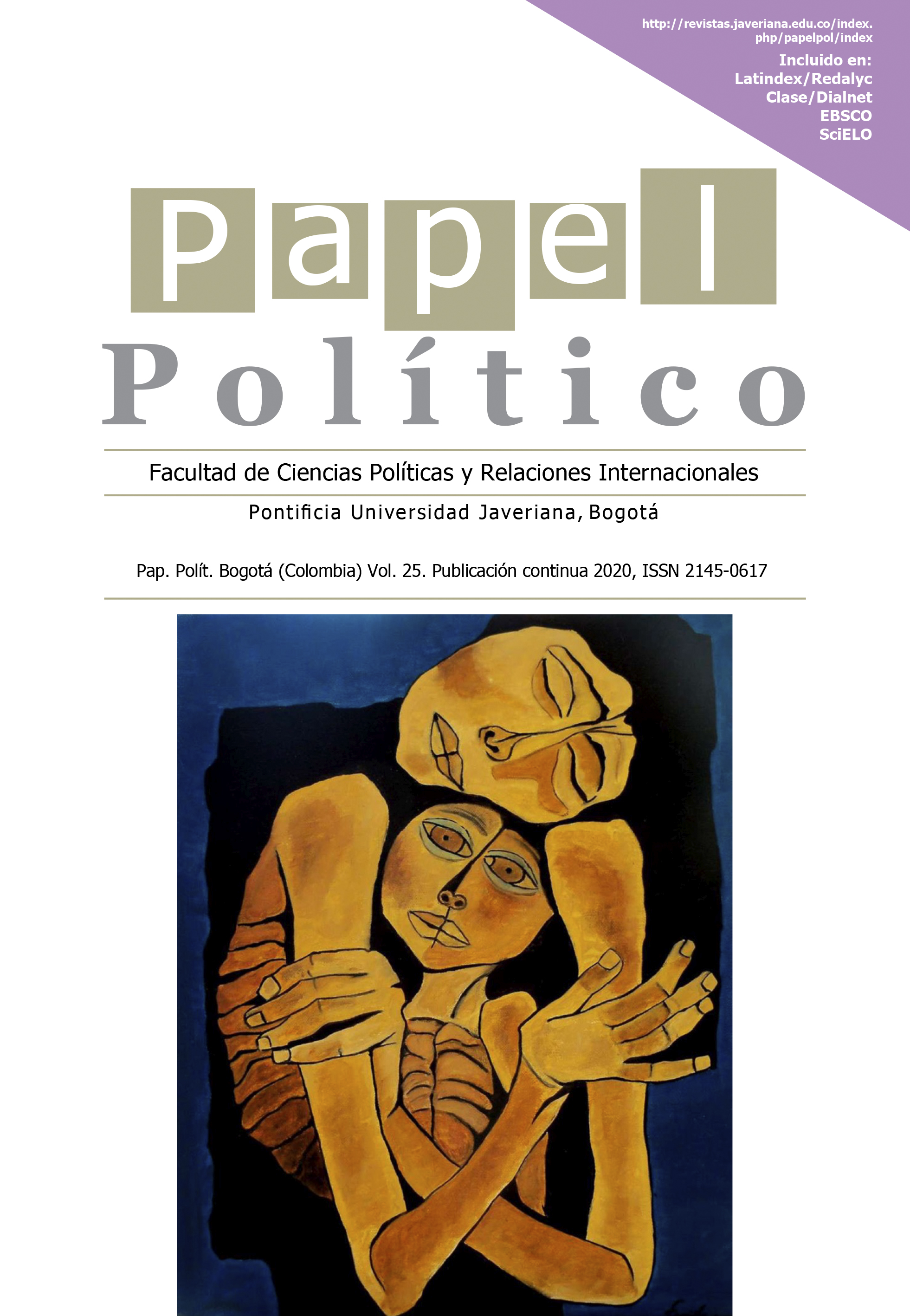Resumen
El propósito del artículo consiste en analizar la profundización de las relaciones bilaterales entre China y Venezuela desde mediados del siglo XXI, insertando sus principales motivaciones dentro de un contexto geopolítico. La hipótesis central del artículo considera que esa aproximación posee un fuerte carácter geopolítico y está intrínsecamente relacionada con la búsqueda, emprendida por China, por medios de reducir su vulnerabilidad energética. En ese sentido, el mantenimiento de las relaciones con Venezuela sería estratégico por tres razones principales: dos de naturaleza geográfica (su ubicación y abundancia de petróleo); y otra política (distanciamiento de la influencia norteamericana). Se considera que el entendimiento de esas relaciones, en diversas ocasiones, tiende a ser simplificado, al ahorcar sólo aspectos económicos. La metodología utilizada consiste en dos etapas: una revisión teórica de los aspectos geopolíticos que permean la seguridad energética de China y una sección empírica, destacando las principales instancias que componen el acercamiento con Venezuela.
Comissão Econômica Para América Latina e o Caribe. (2015). CEPALSTAT: Estadísticas y Indicadores. http://estadisticas.cepal.org/cepalstat/web_cepalstat/estadisticasindicadores.asp
Corrêa, A. P. (2015). Industrialização, Demanda Energética E Indústria De Petróleo E Gás Na China. En M. A. Cintra, E. B, Filho, e E. C. Pinto, (Orgs.), China em Transformação. dimensões econômicas e geopolíticas do desenvolvimento (pp. 189-236). IPEA.
Danrreuther, R (2011). China and Global Oil: vulnerability and opportunity. International Affairs, 87(6), 45-64. https://doi.org/10.1111/j.1468-2346.2011.01040.x
Debter, L. (2018, 24 de maio). The World's Largest Oil and Gas Companies 2017: Exxon Reigns Supreme, While Chevron Slips. Forbes. https://www.forbes.com/sites/laurengensler/2017/05/24/the-worlds-largest-oil-and-gas-companies-2017-exxon-mobil-reigns-supreme-chevron-slips/#2a21e6914f87
Departamento de Estado dos EUA. (2018). Venezuela-Related Sanctions. https://www.state.gov/e/eb/tfs/spi/venezuela/
Dollar, D. (2017, janeiro). China’s Investment in Latin America (Paper 4). Brookings.
Ellis, E. (2009). China in Latin America. the whats and wherefores. Lynne Rienner.
Energy Information Administration. (2015). Venezuela: international energy data and analysis.
Energy Information Administration (2018). China surpassed the United States as the world’s largest crude oil importer in 2017. Today Energy. Feb. 05, 2018. https://www.eia.gov/todayinenergy/detail.php?id=34812
Energy Information Administration (2013). International Energy Outlook. https://www.eia.gov/outlooks/ieo/pdf/0484(2013).pdf
Gallagher, K., Irwin, A., e Koleski, K. (2013). ¿Un mejor trato? Análisis comparativo de los préstamos chinos en América Latina. Universidade Nacional Autônoma do México.
Gautam, P. K. (2011). Mapping Chinese Oil and Gas Pipelines and Sea Routes. Strategic Analysis, 35(4), 595-612. https://doi.org/10.1080/09700161.2011.576510
Hongbo, S. (2014). China-Venezuelan Oil Cooperation Model. Perspectives on Global Development and Technology, 13(5), 648-669. https://doi.org/10.1163/15691497-12341322
International Energy Agency. (2017). Venezuela. https://www.iea.org/countries/non-membercountries/venezuela/
International Energy Agency (2011). World Energy Outlook. Paris: IEA.
Jacobs, B. (2017, 12 de agosto). Trump threatens 'military option' in Venezuela as crisis escalates. The Guardian. https://www.theguardian.com/world/2017/aug/11/donald-trump-venezuela-crisis-military-intervention
Jiang, J., e Sinton, J. (2011). Overseas Investments by China’s National Oil Companies. International Energy Agency.
Klare, M. (2008). Rising Powers, Shrinking Planet: the new geopolitics of energy. Oneworld Publications.
Li, R., e Leung, G. (2011). The Integration of China into the World Crude Oil Market since 1998. Energy Policy, 39, 159-166. https://doi.org/10.1016/j.enpol.2011.05.048
Medeiros, C. A., e Cintra, M. R. V. P. (2015). Impacto da Ascensão Chinesa sobre os Países Latino-americanos. Revista de Economía Política, 35(1), 28-42. https://doi.org/10.1590/0101-31572015v35n01a02
Meidan, M. (2016). China’s Loan for Oil: assets or liability? The Oxford Institute for Energy Studies. https://www.oxfordenergy.org/wpcms/wp-content/uploads/2016/12/Chinas-loans-for-oil-WPM-70.pdf
Ministry of Commerce of People's Republic of China (MOFCOM) (2017). 对外直接投资统计公报 [Boletim Estatístico de Investimento Estrangeiro Direto]. http://images.mofcom.gov.cn/hzs/201810/20181029160118046.pdf
Morais, I. N. (2012). Cadeias Produtivas Globais e Agregação de Valor: a posição da China na indústria eletroeletrônica de consumo. Revista Tempo do Mundo, 4(3), 5-46. https://www.ipea.gov.br/revistas/index.php/rtm/article/view/70
Myers, M., e Gallagher, K. (2017). Chinese Finance to LAC in 2016. China-Latin America Report. The Dialogue. Leadrship for Americas. https://www.thedialogue.org/wp-content/uploads/2017/02/Chinese-Finance-to-LAC-in-2016-Web-and-email-res.pdf
Observatório da Complexidade Económica. (2018). Visualizations. https://atlas.media.mit.edu/en/profile/country
Painter, D. (2012). Oil and the American Century. The Journal of American History: Oil in American History, 99(1), 24-39. http://www.jstor.org/stable/41510299
República Bolivariana da Venezuela (2008). Ley Orgánica de Reordenamiento del Mercado Interno de Los Combustíbles Líquidos. Gazeta Oficial No 39.019, 18 set. 2008. http://www.minpet.gob.ve/images/biblioteca/leyes/Ley_de_reordenamiento_del_mercado.pdf
República Bolivariana da Venezuela (2010). Ley Aprobatoria del Acuerdo entre el Gobierno de la República Bolivariana de Venezuela y el Gobierno de la República Popular China sobre Cooperación para Financiamiento a Largo Plazo”. Gazeta Oficial No 39.511, 16 set. 2010. https://chinaenamericalatina.info/wp-content/uploads/2016/09/Gaceta-Cooperaci%C3%B3n-para-financiamiento-a-largo-plazo.pdf
Robbinson, J. (2012). The Rise of the Petrodollar System: “Dollars for Oil”. Financial Sense. https://www.financialsense.com/contributors/jerry-robinson/the-rise-of-the-petrodollar-system-dollars-for-oil
Serviço Nacional de Estatística da China. (2016). China Statistic Yearbook (2016). http://www.stats.gov.cn/tjsj/ndsj/2016/indexeh.htm
Tan, X. (2013). China’s Overseas Investment in the Energy/Resources Sector: its scale, drivers, challenges and implications. Energy Economics, 36, 750-758. https://doi.org/10.1016/j.eneco.2012.11.019
Visentini, P. F. (2011). A novíssima China e o Sistema Internacional. Revista de Sociología Política, 19(1), 131-141. http://doi.org/10.1590/S0104-44782011000400009
World Bank (2014). Energy use (kg of oil equivalent per capita) - China. https://data.worldbank.org/indicator/EG.USE.PCAP.KG.OE?locations=CN
Zhang, J., e Mingjia, X. (2016). China's Oil Product Pricing Mechanism: What role does it play in China's macroeconomy? China Economic Review, 3, 209-221. https://doi.org/10.1016/j.chieco.2016.02.002
Zhang, J., Fan, Y., e Ji, Q. (2013). An Evaluation Framework for Oil Import Security Based on the Supply Chain with a Case Study Focused on China. Energy Economics, 38, 87-95. https://doi.org/10.1016/j.eneco.2013.03.014

Esta obra está bajo una licencia internacional Creative Commons Atribución 4.0.
Derechos de autor 2022 Ticiana Amaral Nunes


